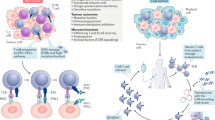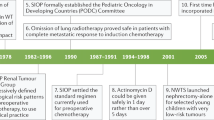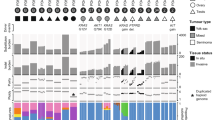Abstract
Several lines of evidence demonstrate that the biology, genetics and environment of childhood solid tumours (CSTs) sets them apart from adult solid tumours. The nature of the progenitor cells from which these tumours arise, and their immature tissue environment, allows CSTs to develop with fewer defects in cell regulatory processes than adult cancers. These differences could explain why CSTs are more susceptible to therapeutic intervention than adult tumours. How does the aetiology of these cancers differ from those occurring in adults and how might this affect the development of more effective therapies?
This is a preview of subscription content, access via your institution
Access options
Subscribe to this journal
Receive 12 print issues and online access
$209.00 per year
only $17.42 per issue
Buy this article
- Purchase on Springer Link
- Instant access to full article PDF
Prices may be subject to local taxes which are calculated during checkout



Similar content being viewed by others
References
Ries, L. A. G. et al. (eds). SEER Cancer Statistics Review, 1975–2002 [online] National Cancer Institute. Bethesda, Maryland, http://seer.cancer.gov/csr/1975_2002/, based on November 2004 SEER data submission, posted to the SEER web site 2005.
Parkin, D. M., Whelan, S. L., Ferlay, J., Teppo, L. & Thomas, D. B. Cancer Incidence in Five Continents VIII. International Agency for Research on Cancer (IARC) Scientific Publications No. 155 (IARC, Lyon, France, 2002).
Stiller, C. A. Population based survival rates for childhood cancer in Britain, 1980–1991. Br. Med. J. 309, 1612–1616 (1994).
Duffner, P. K., Cohen, M. E. & Parker, M. S. Prospective intellectual testing in children with brain tumors. Ann. Neurol. 23, 575–579 (1988).
Jannoun, L. & Bloom, H. J. Long-term psychological effects in children treated for intracranial tumours. Int. J. Radiat. Oncol. Biol. Phys. 18, 747–753 (1990).
Knudson, A. G. Stem cell regulation, tissue ontogeny, and oncogenic events. Semin. Cancer Biol. 3, 99–106 (1992).
Yachnin, S. The clinical significance of human α-fetoprotein. Ann. Clin. Sci. 8, 84–90 (1978).
Van Tornout, J. M. et al. Timing and magnitude of decline in α-fetoprotein levels in treated children with unresectable or metastatic hepatoblastoma are predictors of outcome: a report from the Children's Cancer Group. J. Clin. Oncol. 15, 1190–1197 (1997).
Kho, A. T. et al. Conserved mechanisms across development and tumorigenesis revealed by a mouse development perspective of human cancers. Genes Dev. 18, 629–640 (2004).
Dekel, B. Profiling gene expression in kidney development. Nephron. Exp. Nephrol. 95, e1–e6 (2003).
Ohira, M. et al. Expression profiling and characterization of 4200 genes cloned from primary neuroblastomas: identification of 305 genes differentially expressed between favorable and unfavorable subsets. Oncogene 22, 5525–5536 (2003).
Nakagawara, A. & Ohira, M. Comprehensive genomics linking between neural development and cancer: neuroblastoma as a model. Cancer Lett. 204, 213–224 (2004).
Rickert, C. H. Neuropathology and prognosis of foetal brain tumours. Acta Neuropathol. 98, 567–576 (1999).
Rosenblum, M., Matsutani, M. & Van Meir, E. in Pathology and Genetics of Tumours of the Nervous System (eds Kleihues, P. and Cavenee, W. K.) (International Agency for Research on Cancer, Lyon, France, 2000).
Martin, G. R. Isolation of a pluripotent cell line from early mouse embryos cultured in medium conditioned by teratocarcinoma stem cells. Proc. Natl Acad. Sci. USA 78, 7634–7638 (1981).
Andrews, P. V. From teratocarcinomas to embryonic stem cells. Philos. Trans. R. Soc. Lond. B Biol. Sci. 357, 405–417 (2002).
Boye, E. et al. Clonality and altered behavior of endothelial cells from hemangiomas. J. Clin. Invest. 107, 745–752 (2001).
Ritter, M. R., Dorrell, M. I., Edmonds, J., Friedlander, S. F. & Friedlander, M. Insulin-like growth factor 2 and potential regulators of hemangioma growth and involution identified by large-scale expression analysis. Proc. Natl Acad. Sci. USA 99, 7455–7460 (2002).
Takahashi, K. et al. Cellular markers that distinguish the phases of hemangioma during infancy and childhood. J. Clin. Invest. 93, 2357–2364 (1994).
van Noesel, M. M. & Versteeg, R. Pediatric neuroblastomas: genetic and epigenetic 'danse macabre'. Gene 325, 1–15 (2004).
Miale, T. D. & Kirpekar, K. Neuroblastoma stage IV-S. Med. Oncol. 11, 89–100 (1994).
Fritsch, P., Kerbl, R., Lackner, H. & Urban, C. 'Wait and see' strategy in localized neuroblastoma in infants: an option not only for cases detected by mass screening. Pediatr. Blood Cancer 43, 679–682 (2004).
Dome, J. S. & Coppes, M. J. Recent advances in Wilms tumor genetics. Curr. Opin. Pediatr. 14, 5–11 (2002).
Fukuzawa, R. et al. Epigenetic differences between Wilms' tumours in white and east-Asian children. Lancet 363, 446–451 (2004).
Knudson, A. G. Jr, Hethcote, H. W. & Brown, B. W. Mutation and childhood cancer: a probabilistic model for the incidence of retinoblastoma. Proc. Natl Acad. Sci. USA 72, 5116–5120 (1975).
Jackson, A. L. & Loeb, L. A. The mutation rate and cancer. Genetics 148, 1483–1490 (1998).
Kusafuka, T. et al. Mutation analysis of p53 gene in childhood malignant solid tumors. J. Pediatr. Surg. 32, 1175–1180 (1997).
Thiele, C. J. & Kastan, M. B. in Principles and Practice of Pediatric Oncology (eds Pizzo, P. A. & Poplack, D. G.) 89–119 (Lippincott Williams & Wilkins, Hagerstown, Maryland, USA, 2002).
Toren, A., Amariglio, N. & Rechavi, G. Curable and non-curable malignancies: lessons from paediatric cancer. Med. Oncol. 13, 15–21 (1996).
Olivier, M. et al. The IARC TP53 database: new online mutation analysis and recommendations to users. Hum. Mutat. 19, 607–614 (2002).
Sherr, C. J. Principles of tumor suppression. Cell 116, 235–246 (2004).
Ohgaki, H., Vital, A., Kleihues, P. & Hainaut, P. in Pathology and Genetics of Tumours of the Nervous System (eds Kleihues, P. and Cavenee, W. K.)(International Agency for Research on Cancer, Lyon, France, 2000).
Rajagopalan, H. & Lengauer, C. Aneuploidy and cancer. Nature 432, 338–341 (2004).
Rasheed, B. K. et al. Alterations of the TP53 gene in human gliomas. Cancer Res. 54, 1324–1330 (1994).
Bruder, E. et al. Morphologic and molecular characterization of renal cell carcinoma in children and young adults. Am. J. Surg. Pathol. 28, 1117–1132 (2004).
Dyer, M. & Bremner, R. A. The search for the retinoblastoma cell of origin. Nature Rev. Cancer 5, 91–101 (2005).
Jiang, Z., Zacksenhaus, E., Gallie, B. L. & Phillips, R. A. The retinoblastoma gene family is differentially expressed during embryogenesis. Oncogene 14, 1789–1797 (1997).
Weinberg, R. A. The retinoblastoma protein and cell cycle control. Cell 81, 323–330 (1995).
Robanus-Maandag, E. et al. p107 is a suppressor of retinoblastoma development in pRb-deficient mice. Genes Dev. 12, 1599–1609 (1998).
Trinh, E., Denchi, E. L. & Helin, K. Naturally death-resistant precursor cells revealed as the origin of retinoblastoma. Cancer Cell 5, 513–515 (2004).
Marino, S., Hoogervoorst, D., Brandner, S. & Berns, A. Rb and p107 are required for normal cerebellar development and granule cell survival but not for Purkinje cell persistence. Development 130, 3359–3368 (2003).
Chen, D. et al. Cell-specific effects of RB or RB/p107 loss on retinal development implicate an intrinsically death-resistant cell-of-origin in retinoblastoma. Cancer Cell 5, 539–551 (2004).
Kaatsch, P., Rickert, C. H., Kuhl, J., Schuz, J. & Michaelis, J. Population-based epidemiological data on brain tumours in German children. Cancer 92, 3155–3164 (2001).
Hahn, H. et al. Mutations of the human homolog of Drosophila patched in the nevoid basal cell carcinoma syndrome. Cell 85, 841–851 (1996).
Johnson, R. L. et al. Human homolog of patched, a candidate gene for the basal cell nevis syndrome. Science 272, 1668–1671 (1996).
Ruiz i Altaba, A., Stecca, B. & Sanchez, P. Hedgehog–Gli signaling in brain tumors: stem cells and paradevelopmental programs in cancer. Cancer Lett. 204, 145–157 (2004).
Dahmane, N. & Ruiz-i-Altaba, A. Sonic hedgehog regulates the growth and patterning of the cerebellum. Development 126, 3089–3100 (1999).
Wechsler-Reya, R. J. & Scott, M. P. Control of neuronal precursor proliferation in the cerebellum by sonic hedgehog. Neuron 22, 103–114 (1999).
Taylor, M. D. et al. Mutations in SUFU predispose to medulloblastoma. Nature Genet. 31, 306–310 (2002).
Gilbertson, R. J. Medulloblastoma: signalling a change in treatment. Lancet Oncol. 5, 209–218 (2004).
Hamilton, S. R. et al. The molecular basis of Turcot's syndrome. N. Engl. J. Med. 332, 839–847 (1995).
Meng, X. et al. Suppressor of fused negatively regulates β-catenin signaling. J. Biol. Chem. 276, 40113–40119 (2001).
Berman, D. M. et al. Medulloblastoma growth inhibition by hedgehog pathway blockade. Science 297, 1559–1561 (2002).
Kalapurakal, J. A. et al. Management of Wilms' tumour: current practice and future goals. Lancet Oncol. 5, 37–46 (2004).
Call, K. M. et al. Isolation and characterization of a zinc finger polypeptide gene at the human chromosome 11 Wilms' tumor locus. Cell 60, 509–520 (1990).
Gessler, M. et al. Homozygous deletion in Wilms tumours of a zinc-finger gene identified by chromosome jumping. Nature 343, 774–778 (1990).
Little, M., Holmes, G. & Walsh, P. WT1: what has the last decade told us? Bioessays 21, 191–202 (1999).
Wagner, K. D., Wagner, N. & Schedl, A. The complex life of WT1. J. Cell Sci. 116, 1653–1658 (2003).
Kreidberg, J. A. et al. WT-1 is required for early kidney development. Cell 74, 679–691 (1993).
Davies, J. A. et al. Development of an siRNA-based method for repressing specific genes in renal organ culture and its use to show that the Wt1 tumour suppressor is required for nephron differentiation. Hum. Mol. Genet. 13, 235–246 (2004).
Rose, E. A. et al. Complete physical map of the WAGR region of 11p13 localizes a candidate Wilms' tumor gene. Cell 60, 495–508 (1990).
Coppes, M. J. et al. Inherited WT1 mutation in Denys–Drash syndrome. Cancer Res. 52, 6125–6128 (1992).
Armstrong, J. F., Pritchard-Jones, K., Bickmore, W. A., Hastie, N. D. & Bard, J. B. The expression of the Wilms' tumour gene, WT1, in the developing mammalian embryo. Mech. Dev. 40, 85–97 (1993).
Pelletier, J. et al. Germline mutations in the Wilms' tumor suppressor gene are associated with abnormal urogenital development in Denys–Drash syndrome. Cell 67, 437–447 (1991).
Buendia, M. A. Genetic alterations in hepatoblastoma and hepatocellular carcinoma: common and distinctive aspects. Med. Pediatr. Oncol. 39, 530–535 (2002).
Steenman, M., Westerveld, A. & Mannens, M. Genetics of Beckwith–Wiedemann syndrome-associated tumors: common genetic pathways. Genes Chromosom. Cancer 28, 1–13 (2000).
Niles, R. M. Signaling pathways in retinoid chemoprevention and treatment of cancer. Mutat. Res. 555, 81–96 (2004).
Tallman, M. S. Acute promyelocytic leukemia as a paradigm for targeted therapy. Semin. Hematol. 41, 27–32 (2004).
Qualtrough, D., Buda, A., Gaffield, W., Williams, A. C. & Paraskeva, C. Hedgehog signalling in colorectal tumour cells: induction of apoptosis with cyclopamine treatment. Int. J. Cancer 110, 831–837 (2004).
Tabs, S. & Avci, O. Induction of the differentiation and apoptosis of tumor cells in vivo with efficiency and selectivity. Eur. J. Dermatol. 14, 96–102 (2004).
Singh, S. K. et al. Identification of human brain tumour initiating cells. Nature 432, 396–401 (2004).
Tamaki, S. et al. Engraftment of sorted/expanded human central nervous system stem cells from fetal brain. J. Neurosci. Res. 69, 976–986 (2002).
Little, J. Epidemiology of Childhood Cancer. International Agency for Research on Cancer (IARC) Scientific Publications No. 149 (IARC, Lyon, France, 1999).
Parkin, D. M. et al. International Incidence of Childhood Cancer. International Agency for Research on Cancer (IACR) Scientific Publications No. 144 (IARC, Lyon, France, 1998)
Raffel, C. et al. Sporadic medulloblastomas contain PTCH mutations. Cancer Res. 57, 842–845 (1997).
Verloes, A. et al. Ondine–Hirschsprung syndrome (Haddad syndrome). Further delineation in two cases and review of the literature. Eur. J. Pediatr. 152, 75–77 (1993).
Trochet, D. et al. Germline mutations of the paired-like homeobox 2B (PHOX2B) gene in neuroblastoma. Am. J. Hum. Genet. 74, 761–764 (2004).
Amiel, J. et al. Polyalanine expansion and frameshift mutations of the paired-like homeobox gene PHOX2B in congenital central hypoventilation syndrome. Nature Genet. 33, 459–461 (2003).
Oosterhuis, J. W. & Looijenga, L. H. Testicular germ-cell tumours in a broader perspective. Nature Rev. Cancer 5, 210–222 (2005).
Acknowledgements
Author information
Authors and Affiliations
Corresponding author
Ethics declarations
Competing interests
The authors declare no competing financial interests.
Supplementary information
Related links
Related links
DATABASES
Entrez Gene
National Cancer Institute
OMIM
Glossary
- METANEPHRIC DEVELOPMENT
-
The metanephros is the permanent kidney of adult amniotes. This forms later than the transient pronephros of the early embryo.
- NEURAL CREST
-
The neural crest is a multipotent population of cells that arises from the dorsal aspect of the early neural tube. These cells migrate widely throughout the body and form almost all of the components of the peripheral nervous system as well as other non-neural cell types such as the melanocytes of the skin and bone and muscle of the face.
- SYMPATHOADRENAL
-
The sympathoadrenal lineage is one fate of neural crest cells and represents a common progenitor of the adrenergic sympathetic neurons and the medullary cells of the adrenal gland.
- PURKINJE CELLS
-
Purkinje cells are very large neurons of the cerebellum with a highly arborized dendritic tree. They are responsible for all output from the cerebellar cortex.
- URETERIC BUDS
-
Ureteric buds represent the leading edges of the epithelial tubules that grow and branch from the nephric ducts to form the kidney tubules. The ureteric buds signal to surrounding mesenchyme to form the nephrons.
- NEPHROGENIC RESTS
-
Nephrogenic rests are clusters of developmentally immature cells and dysplastic cellular arrangements.
Rights and permissions
About this article
Cite this article
Scotting, P., Walker, D. & Perilongo, G. Childhood solid tumours: a developmental disorder. Nat Rev Cancer 5, 481–488 (2005). https://doi.org/10.1038/nrc1633
Published:
Issue Date:
DOI: https://doi.org/10.1038/nrc1633
This article is cited by
-
A somatic mutation in PIK3CD unravels a novel candidate gene for lymphatic malformation
Orphanet Journal of Rare Diseases (2021)
-
Depicting the genetic architecture of pediatric cancers through an integrative gene network approach
Scientific Reports (2020)
-
microRNA-138-5p as a Worse Prognosis Biomarker in Pediatric, Adolescent, and Young Adult Osteosarcoma
Pathology & Oncology Research (2020)
-
MYCN and PRC1 cooperatively repress docosahexaenoic acid synthesis in neuroblastoma via ELOVL2
Journal of Experimental & Clinical Cancer Research (2019)
-
The ubiquitin-proteasome pathway in adult and pediatric brain tumors: biological insights and therapeutic opportunities
Cancer and Metastasis Reviews (2017)



